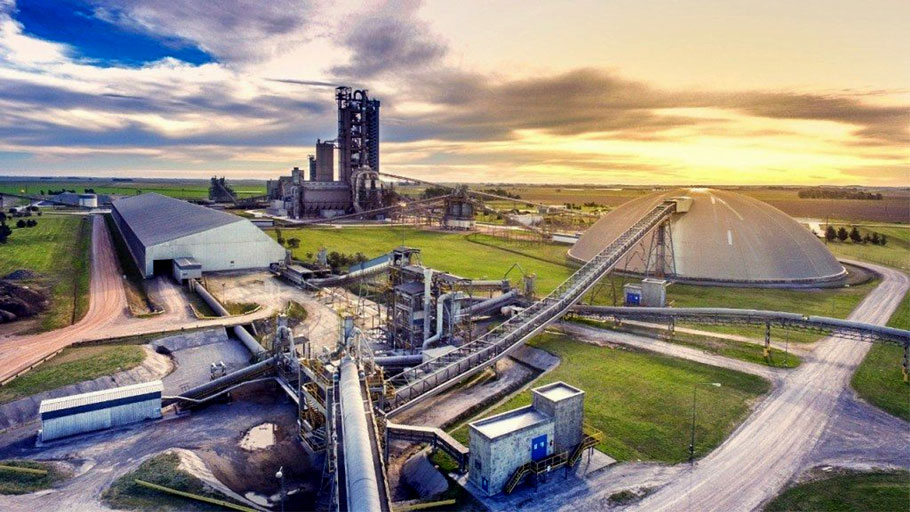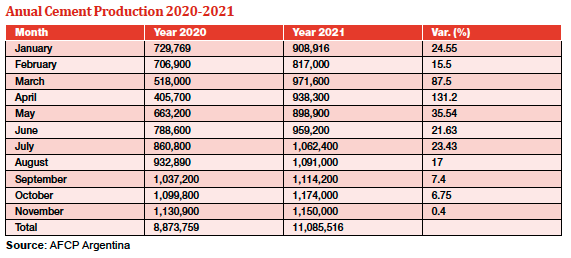By Mauro Nogarin

According to the new financial report published by the Central Bank, the Argentine economy this year will register an increase of 4% if the country closes the agreement with the International Monetary Fund (IMF) to refinance its $45 billion dollar debt.
Regarding inflation, one of the main macroeconomic problems that is more difficult to solve, for this year it will reach 45%, which will continue to generate a constant increase in the price of cement and other construction materials.
According to another report on the main budgetary variables released by the Ministry of Economy, the government expects that this year the demand of the private domestic market will grow by 4.6% and the public, 3.1%, while investment will advance 6.6 %, after having recovered 31% this year, thus marking the activation of the private construction and public works sector.
On the other hand, for 2022 a trade surplus of $9.3 billion is also projected, that is, below the positive balance of $12.9 billion in 2021, after an increase of 7.5% in exports and 9.4 % in imports forecast for 2022.
According to data from the Statistics Institute (INDEC), industry and construction closed 2021 with significant interannual growth rates, reaching 10.1% and 8.4%, respectively, in the month of November.
The objective of the Casa Propia – Construir Futuro Program was the basis for increasing the construction of private homes throughout the country during the 2021-2023 triennium, thanks to financing at a very low interest rate. This is to improve habitat conditions and housing. According to the project, the government will build 120,000 homes by Dec. 31, 2023.
Regarding public works, the Ministry remarked that in 2019 there were 318 works under construction, of which 60% were paralyzed and there are currently 3,000 works throughout the country with a budget that represents 2.4% of the GDP of Argentina.
The works announced by the Minister according to the type and sectors include road works (32.61%), water and sanitation (21.7%), social housing (12.81%), urban facilities (17.23%), sanitary infrastructure (6.72%) and hydraulic infrastructure (3.91%).

The Portland Cement Manufacturers Association (AFCP) in its last report in November, said monthly cement shipments reached 1,150,000 tons, thus accumulating approximately 11 million tons.
In this way, the monthly figure was 0.2% below the dispatches of October and 1.5% above the record for November 2020. Regarding the annual accumulated, it exceeded 25% from the prior year to consolidate the situation of the cement sector in the four companies that make up the item.
Regarding cement consumption, it was reported that in November it reached 1,142,140 tons to accumulate 11.8 million in 11 months, registering an increase of 25.3% year-on-year.
According to data from the Portland Cement Manufacturers Association (AFCP) in the country, cement consumption had an increase of 4.6% year-on-year in November, a rise below the previous months, thus sustaining five consecutive months deceleration. Seen in volume, 1,142,127 tons were consumed in November, being the best November since 2017.
According to statistical data from the Argentine Cement Manufacturers Association (AFCP), cement production, except for the month of January 2021, the other months registered significant increases thanks to the reactivation of public works mostly abandoned in 2020. In the month of April 2021, the greatest increase is observed due to the beginning of the restriction measures promulgated by President Alberto Fernandez in April 2020, when the first cases of Covid-19 were detected.
Because of the difficult inflationary situation that the country is going through, it is also reflected in prices, where in commerce they sell a bag of cement (50 Kg) at $12.50 and according to the same merchants, from January 2022 there will be an increase of 4% .
Regarding investments in the cement industry, the inauguration of the second cement production line at the L’Amalí Plant, which belongs to the Loma Negra firm, stands out with an investment of $350 million.
This new expansion will increase the company’s total capacity by 40%, create 160 new jobs, and take clinker production.According to an official statement, the new expansion has technology that seeks to reduce the carbon footprint by 40% from the substitution of fossil fuels with alternative energy sources derived from co-processed waste within the framework of the development of the economy, circular and diversification of the energy matrix.
Another important investment that has stood out in this sector in recent months is the inauguration of the new comprehensive cement production line at the plant in the town of Malagueño located in the province of Cordoba, in which $120 million was invested.
Mauro Nogarin is Cement Americas Latin American correspondent.



